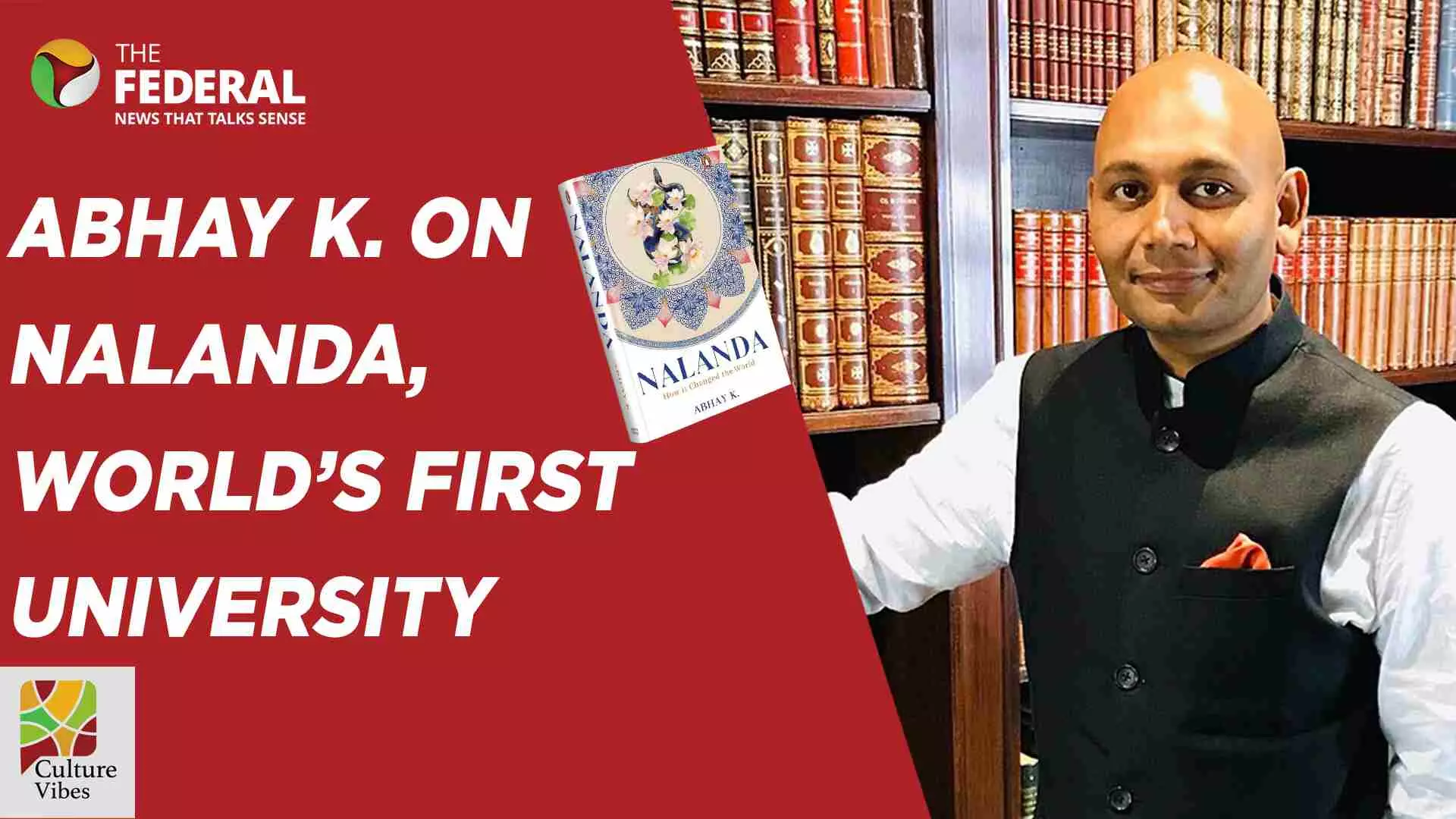
Abhay K
Abhay K. interview: ‘Nalanda gave birth to the idea of a university’
Poet-diplomat-author Abhay K. on his book, ‘Nalanda: How It Changed the World,’ and how the ancient seat of learning, which had a secular and universal curriculum, never died

In the latest episode of Culture Vibes, The Federal’s special programme, anchor Nawaid Anjum speaks with poet, diplomat, and author Abhay K about his latest book, Nalanda: How It Changed the World, published by Penguin Random House India. Abhay K, who also serves as the Deputy Director General of the Indian Council of Cultural Relations in Delhi, delves into Nalanda’s historical, philosophical, and educational significance, exploring how it shaped intellectual traditions worldwide.
Nalanda’s rise and location
Nalanda’s prominence, Abhay K explains, was influenced by its geographical proximity to Rajagriha (Rajgir in modern-day Bihar) and Pataliputra, the capital of the Magadh Empire. Rajagriha, a thriving economic and spiritual centre, was frequented by Buddha and his disciples, including Sariputra and Moggallana, whose presence made Nalanda an attractive location for scholars. The fertile lands of Magadh supported thousands of monks who resided at Nalanda, making it an ideal place for a great centre of learning.
A hub of universal learning
Nalanda was more than a Buddhist centre—it had a secular and universal curriculum, teaching subjects like Sanskrit grammar, medicine, logic, and mathematics. “Aryabhata, the first mathematician to use zero as a digit, taught here,” Abhay K notes, highlighting its academic breadth. Texts carried by Xuanzang to China in the 7th century further prove Nalanda’s diverse teachings, spanning multiple disciplines beyond Buddhist philosophy.
Royal patronage and political significance
Nalanda received patronage from rulers across centuries, from Emperor Ashoka, who built the stupa of Sariputra, to the Guptas and the Palas. Though the Guptas were primarily Hindu, some supported Buddhism and saw Nalanda as a centre for training administrators, scholars, and experts in various fields. The university’s significance extended beyond religion, as rulers viewed it as a cultural and political asset, fostering educated minds essential for governance.
Intellectual traditions and debates
Debate and discourse were central to Nalanda’s teaching methods. “Anyone could come and engage in discussions with the Dwarkapala Pandit, who assessed their intellectual capabilities,” Abhay K explains. This rigorous academic atmosphere encouraged critical thinking and shaped major Buddhist philosophies, including Nagarjuna’s Madhyamaka doctrine, which introduced the concept of Shunyata (emptiness). The university accommodated diverse sects, including Hinayana and Mahayana Buddhism, fostering an inclusive academic environment.
Decline and destruction
While Nalanda declined gradually due to shifting political dynamics and reduced patronage, its final destruction is attributed to Bakhtiyar Khilji’s invasion in the 12th century. However, Abhay K clarifies that historical sources directly linking Khilji to Nalanda’s destruction are scarce. “Nalanda was too vast to be destroyed in one or two raids,” he says, adding that its decline had already begun due to internal conflicts and economic instability.
Influence on modern universities
Nalanda’s architectural layout, featuring structured courtyards and monastic design, influenced the formation of European universities like Oxford and Cambridge. “Christopher Beckwith’s Warriors of the Cloisters: The Central Asian Origins of Science in the Medieval World traces the origins of European colleges to Buddhist viharas, which were modeller on Nalanda’s monastic establishments,” Abhay K explains. The standardised architectural plan of Nalanda, with its massive campus and structured learning system, laid the foundation for modern universities.
Challenge of historical amnesia
Despite its global recognition, Nalanda remains underappreciated in India. “I am from Nalanda, yet people there barely know about its great masters,” Abhay K laments. While Nalanda’s intellectual contributions are well-documented in Tibetan and Chinese texts, its legacy has been overshadowed in its homeland. “We lost our self-confidence due to colonialism, forgetting that we were capable of great things,” he adds, emphasizing the need to reclaim and celebrate Nalanda’s heritage.
Nalanda’s revival and future
Efforts to revive Nalanda began post-independence, with the establishment of Nav Nalanda Mahavihara in 1951, supported by India’s first president, Dr. Rajendra Prasad. The government later founded Nalanda University in 2010, with operations beginning in 2014. “The university’s new campus, a net-zero facility in Rajgir, marks a hopeful resurgence of Nalanda’s intellectual tradition,” Abhay K notes.
Beyond India, institutions named after Nalanda exist worldwide, from France to Malaysia. “The idea of Nalanda never died,” Abhay K affirms, highlighting the university’s lasting impact on global education. The question now is whether its revival can inspire a new era of knowledge exchange, intellectual curiosity, and educational excellence.
The content above has been generated using a fine-tuned AI model. To ensure accuracy, quality, and editorial integrity, we employ a Human-In-The-Loop (HITL) process. While AI assists in creating the initial draft, our experienced editorial team carefully reviews, edits, and refines the content before publication. At The Federal, we combine the efficiency of AI with the expertise of human editors to deliver reliable and insightful journalism.

